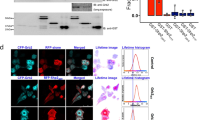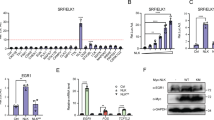Abstract
Sprouty (Spry) inhibits signalling by receptor tyrosine kinases; however, the molecular mechanism underlying this function has not been defined. Here we show that after stimulation by growth factors Spry1 and Spry2 translocate to the plasma membrane and become phosphorylated on a conserved tyrosine. Next, they bind to the adaptor protein Grb2 and inhibit the recruitment of the Grb2–Sos complex either to the fibroblast growth factor receptor (FGFR) docking adaptor protein FRS2 or to Shp2. Membrane translocation of Spry is necessary for its phosphorylation, which is essential for its inhibitor activity. A tyrosine-phosphorylated octapeptide derived from mouse Spry2 inhibits Grb2 from binding FRS2, Shp2 or mouse Spry2 in vitro and blocks activation of the extracellular-signal-regulated kinase (ERK) in cells stimulated by growth factor. A non-phosphorylated Spry mutant cannot bind Grb2 and acts as a dominant negative, inducing prolonged activation of ERK in response to FGF and promoting the FGF-induced outgrowth of neurites in PC12 cells. Our findings suggest that Spry functions in a negative feedback mechanism in which its inhibitor activity is controlled rapidly and reversibly by post-translational mechanisms.
This is a preview of subscription content, access via your institution
Access options
Subscribe to this journal
Receive 12 print issues and online access
$209.00 per year
only $17.42 per issue
Buy this article
- Purchase on Springer Link
- Instant access to full article PDF
Prices may be subject to local taxes which are calculated during checkout








Similar content being viewed by others
References
Hunter, T. The croonian lecture, 1997. The phosphorylation of proteins on tyrosine: its role in cell growth and disease. Phil. Trans. R. Soc. Lond. B. 353, 583–605 (1998).
Schlessinger, J. Cell signaling by receptor tyrosine kinases. Cell 103, 211–225 (2000).
Pawson, T. & Saxton, T. M. Signaling networks-do all roads lead to the same genes? Cell 97, 675–678 (1999).
Simon, M. A. Receptor tyrosine kinases: specific outcomes from general signals. Cell 103, 13–15 (2000).
Hunter, T. Signaling-2000 and beyond. Cell 100, 113–127 (2000).
Freeman, M. Feedback control of intercellular signalling in development. Nature 408, 313–319 (2000).
Perrimon, N. & McMahon, A. P. Negative feedback mechanisms and their roles during pattern formation. Cell 97, 13–16 (1999).
Golembo, M., Schweitzer, R., Freeman, M. & Shilo, B. Z. argos transcription is induced by the Drosophila EGF receptor pathway to form an inhibitory feedback loop. Development 122, 223–230 (1996).
Ghiglione, C. et al. The transmembrane molecule kekkon 1 acts in a feedback loop to negative regulate the activity of the Drosophila EGF receptor during oogenesis. Cell 96, 847–856 (1999).
Nakao, A. et al. Identification of Smad7, a TGFβ-inducible antagonist of TGF-β signalling. Nature 389, 631–635 (1997).
Yasukawa, H., Sasaki, A. & Yoshimura, A. Negative regulation of cytokine signaling pathways. Annu. Rev. Immunol. 18, 143–164 (2000).
Tsang, M., Friesel, R., Kudoh, T. & Dawid, I. B. Identification of Sef, a novel modulator of FGF signaling. Nat. Cell Biol. 4, 165–169 (2002).
Furthauer, M., Lin, W., Ang, S.-L., Thisse, B. & Thisse, C. Sef is a feedback-induced antagonist of Ras/MAPK-mediated FGF signaling. Nat. Cell Biol. 4, 170–174 (2002).
Hacohen, N., Kramer, S., Sutherland, D., Hiromi, Y. & Krasnow, M. A. sprouty encodes a novel antagonist of FGF signaling that patterns apical branching of the Drosophila airways. Cell 92, 253–263 (1998).
Casci, T., Vinos, J. & Freeman, M. Sprouty, an intracellular inhibitor of Ras signalling. Cell 96, 655–665 (1999).
Kramer, S., Okabe, M., Hacohen, N., Krasnow, M. A. & Hiromi, Y. Sprouty: a common antagonist of FGF and EGF signaling pathways in Drosophila. Development 126, 2515–2525 (1999).
Reich, A., Sapir, A. & Shilo, B. Z. Sprouty is a general inhibitor of receptor tyrosine kinase signaling. Development 126, 4139–4147 (1999).
Minowada, G., et al. Vertebrate Sprouty genes are induced by FGF signaling and can cause chondrodysplasia when overexpressed. Development 126, 4465–4475 (1999).
de Maximy, A. A. et al. Cloning and expression pattern of a mouse homologue of Drosophila sprouty in the mouse embryo. Mech. Dev. 81, 213–216 (1999).
Chambers, D. & Mason, I. Expression of sprouty2 during early development of the chick embryo is coincident with known sites of FGF signalling. Mech. Dev. 91, 361–364 (2000).
Mailleux, A. A. et al. Evidence that SPROUTY2 functions as an inhibitor of mouse embryonic lung growth and morphogenesis. Mech. Dev. 102, 81–94 (2001).
Tefft, J. D. et al. Conserved function of mSpry-2, a murine homolog of Drosophila sprouty, which negatively modulates respiratory organogenesis. Curr. Biol. 9, 219–222 (1999).
Nutt, S. L., Dingwell, K. S., Holt, C. E. & Amaya, E. Xenopus Sprouty2 inhibits FGF-mediated gastrulation movements but does not affect mesoderm induction and patterning. Genes Dev. 15, 1152–1166 (2001).
Lee, S. H., Schloss, D. J., Jarvis, L., Krasnow, M. A. & Swain, J. L. Inhibition of angiogenesis by a mouse sprouty protein. J. Biol. Chem. 276, 4128–4133 (2001).
Impagnatiello, M. A. et al. Mammalian sprouty-1 and -2 are membrane-anchored phosphoprotein inhibitors of growth factor signaling in endothelial cells. J. Cell Biol. 152, 1087–1098 (2001).
Gross, I., Bassit, B., Benezra, M. & Licht, J. D. Mammalian Sprouty proteins inhibit cell growth and differentiation by preventing Ras activation. J. Biol. Chem. 276, 46460–46468 (2001).
Furthauer, M., Reifers, F., Brand, M., Thisse, B. & Thisse, C. Sprouty4 acts in vivo as a feedback-induced antagonist of FGF signaling in zebrafish. Development 128, 2175–2186 (2001).
Yusoff, P. et al. Sprouty2 inhibits the Ras/MAP kinase pathway by inhibiting the activation of Raf. J. Biol. Chem. 277, 3195–3201 (2002).
Sasaki, A., Taketomi, T., Wakioka, T., Kato, R. & Yoshimura, A. Identification of a dominant negative mutant of Sprouty that potentiates fibroblast growth factor- but not epidermal growth factor-induced ERK activation. J. Biol. Chem. 276, 36804–36808 (2001).
Pawson, T. & Gish, G. D. SH2 and SH3 domains: from structure to function. Cell 71, 359–362 (1992).
Kouhara, H. et al. A lipid-anchored Grb2-binding protein that links FGF-receptor activation to the Ras/MAPK signaling pathway. Cell 89, 693–702 (1997).
Scott, S. G., Stern, M. J. & Horvitz, H. R. C. elegans cell-signalling gene sem-5 encodes a protein with SH2 and SH3 domains. Nature 356, 340–344 (1992).
Kusakabe, M., Masuyama, N., Hanafusa, H. & Nishida, E. Xenopus FRS2 is involved in early embryogenesis in cooperation with the Src family kinase Laloo. EMBO Reports 2, 727–735 (2001).
Lim, J. et al. Sprouty proteins are targeted to membrane ruffles upon growth factor receptor tyrosine kinase activation. J. Biol. Chem. 275, 32837–32845 (2000).
Marshall, C. J. Specificity of receptor tyrosine kinase signaling: transient versus sustained extracellular signal-regulated kinase activation. Cell 80, 179–185 (1995).
Hadari, Y. R., Kouhara, H., Lax, I. & Schlessinger, J. Binding of Shp2 tyrosine phosphatase to FRS2 is essential for fibroblast growth factor-induced PC12 cell differentiation. Mol. Cell. Biol. 18, 3966–3973 (1998).
Wong, E. S. M., Lim, J., Low, B. C., Chen, Q. & Guy, G. R. Evidence for direct interaction between Sprouty and Cbl. J. Biol. Chem. 276, 5866–5875 (2001).
Smart, E. J. et al. Caveolins, liquid-ordered domains, and signal transduction. Mol. Cell Biol. 19, 7289–7304 (1999).
Wong, A., Lamothe, B., Lee, A., Schlessinger, J. & Lax, I. FRS2α attenuates FGF receptor signalling by Grb2-mediated recruitment of the ubiquitin ligase Cbl. Proc. Natl. Acad. Sci. USA 99, 6684–6689 (2002).
Joazeiro, C. A. P. et al. The tyrosine kinase negative regulator c-Cbl as a RING-type, E2-dependent ubiquitin-protein ligase. Science 286, 309–312 (1999).
Rodriguez-Viciana, P. et al. Phosphatidylinositol-3-OH kinase as a direct target of Ras. Nature 370, 527–532 (1994).
Hanafusa, H., Masuyama, N., Kusakabe, M., Shibuya, H. & Nishida, E. The TGF-β family member derriere is involved in regulation of the establishment of left–right asymmetry. EMBO Rep. 1, 32–39 (2000).
Acknowledgements
We thank M. Kasuga for the mouse Grb2 cDNA; S. Kamakura for the mouse Spry2 cDNA; and M. Kusakabe and S. Nishimoto for technical assistance and discussion. This work was supported by grants from the Ministry of Education, Science and Culture of Japan (to E.N).
Author information
Authors and Affiliations
Corresponding author
Ethics declarations
Competing interests
The authors declare no competing financial interests.
Rights and permissions
About this article
Cite this article
Hanafusa, H., Torii, S., Yasunaga, T. et al. Sprouty1 and Sprouty2 provide a control mechanism for the Ras/MAPK signalling pathway. Nat Cell Biol 4, 850–858 (2002). https://doi.org/10.1038/ncb867
Received:
Revised:
Accepted:
Published:
Issue Date:
DOI: https://doi.org/10.1038/ncb867
This article is cited by
-
Illuminating phenotypic drug responses of sarcoma cells to kinase inhibitors by phosphoproteomics
Molecular Systems Biology (2023)
-
Targeting the RAS/RAF/MAPK pathway for cancer therapy: from mechanism to clinical studies
Signal Transduction and Targeted Therapy (2023)
-
SHP2 inhibitors maintain TGFβ signalling through SMURF2 inhibition
npj Precision Oncology (2023)
-
SPRY4 inhibits and sensitizes the primary KIT mutants in gastrointestinal stromal tumors (GISTs) to imatinib
Gastric Cancer (2023)
-
Comparative whole-genome transcriptome analysis in renal cell populations reveals high tissue specificity of MAPK/ERK targets in embryonic kidney
BMC Biology (2022)



